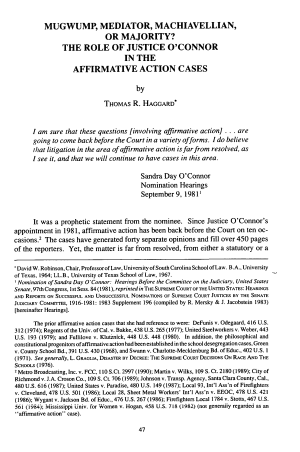Mugwump, Mediator, Machiavellian, or Majority? The Role of Justice O'Connor in the Affirmative Action Cases
January 1990

Other pages in the O'Connor Institute Online Archive mentioned in this article:
| NAME / TITLE | TYPE |
|---|---|
| Metro Broadcasting v. FCC | Supreme Court Opinion |
| City of Richmond v. J. A. Croson Co | Supreme Court Opinion |
| Wygant v. Jackson Bd. of Educ | Supreme Court Opinion |
| Firefighters v. Stotts | Supreme Court Opinion |
DISCLAIMER: This text has been transcribed automatically and may contain substantial inaccuracies due to the limitations of automatic transcription technology. This transcript is intended only to make the content of this document more easily discoverable and searchable. If you would like to quote the exact text of this document in any piece of work or research, please view the original using the link above and gather your quote directly from the source. The Sandra Day O'Connor Institute does not warrant, represent, or guarantee in any way that the text below is accurate.
Article Text
(Excerpt, Automatically generated)
MUGWUMP, MEDIATOR, MACHIAVELLIAN, OR MAJORITY?
THE ROLE OF JUSTICE O'CONNOR IN THE
AFFIRMATIVE ACTION CASES
by
THOMAS R. HAGGARD
I am sure that these questions [involving affirmative action]... are going to come back before the Court in a variety of forms. I do believe that litigation in the area of affirmative action is far from resolved, as I see it, and that we will continue to have cases in this area.
Sandra Day O'Connor Nomination Hearings September 9, 1981
It was a prophetic statement from the nominee. Since Justice O'Connor's appointment in 1981, affirmative action has been back before the Court on ten occasions.2 The cases have generated forty separate opinions and fill over 450 pages of the reporters. Yet, the matter is far from resolved, from either a statutory or a
David W. Robinson, Chair, Professor of Law, University of South Carolina School of Law. B.A., University of Texas, 1964; LLB., University of Texas School of Law, 1967.
1 Nomination of Sandra Day O'Connor: Hearings Before the Committee on the Judiciary, United States
Senate, 97th Congress, 1st Sess. 84 (1981), reprinted in THE SUPREME COURT OF THE UNITED STATES: HEARINGS AND REPORTS ON SUCCESSFUL AND UNSUCCESSFUL NOMINATIONS OF SUPREME COURT JUSTICES BY THE SENATE Judiciary Committee, 1916-1981: 1983 Supplement 196 (compiled by R. Mersky & J. Jacobstein 1983) [hereinafter Hearings].
The prior affirmative action cases that she had reference to were: DeFunis v. Odegaard, 416 U.S. 312 (1974); Regents of the Univ. of Cal. v. Bakke, 438 U.S. 265 (1977); United Steelworkers v. Weber, 443 U.S. 193 (1979); and Fullilove v. Klutznick, 448 U.S. 448 (1980). In addition, the philosophical and constitutional progenitors of affirmative action had been established in the school desegregation cases, Green v. County School Bd., 391 U.S. 430 (1968), and Swann v. Charlotte-Mecklenburg Bd. of Educ., 402 U.S. 1 (1971). See generally, L. GRAGLIA, DISASTER BY DECREE: THE SUPREME COURT DECISIONS ON RAcE AND THE SCHOOLS (1976).
2 Metro Broadcasting, Inc. v. FCC, 110 S.Ct. 2997 (1990); Martin v. Wilks, 109 S. Ct. 2180 (1989); City of Richmond v. J.A. Croson Co., 109 S. Ct. 706 (1989); Johnson v. Transp. Agency, Santa Clara County, Cal., 480 U.S. 616 (1987); United States v. Paradise, 480 U.S. 149 (1987); Local 93, Int'! Ass'n of Firefighters v. Cleveland, 478 U.S. 501 (1986); Local 28, Sheet Metal Workers' Int'! Ass'n v. EEOC, 478 U.S. 421 (1986); Wygant v. Jackson Bd. of Educ., 476 U.S. 267 (1986); Firefighters Local 1784 v. Stotts, 467 U.S. 56i (i984); Mississippi Univ. for Women v. Hogan, 458 U.S. 7i8 (i982) (not generaiiy regarded as an "affirmative action" case).
